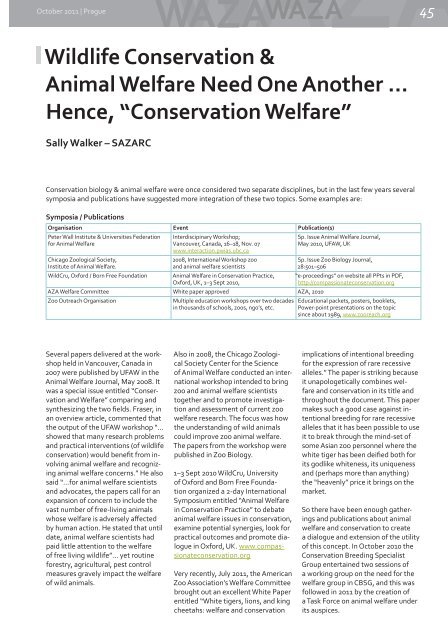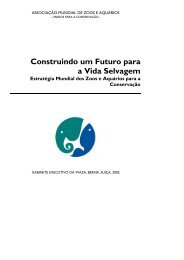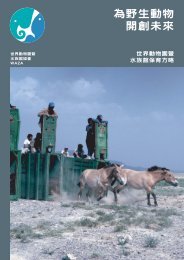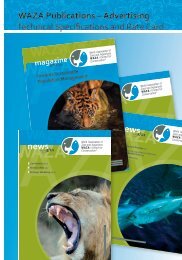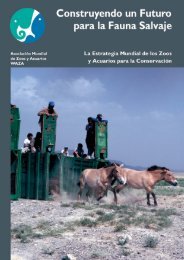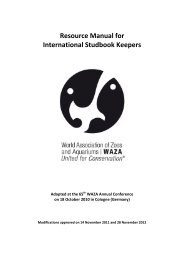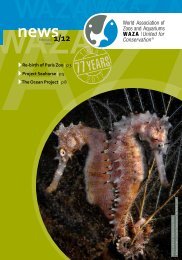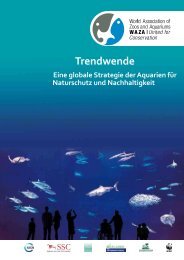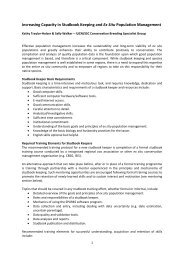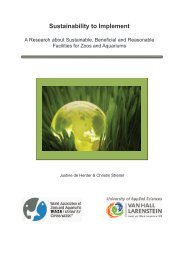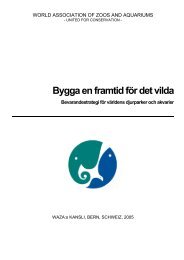Prague - WAZA
Prague - WAZA
Prague - WAZA
Create successful ePaper yourself
Turn your PDF publications into a flip-book with our unique Google optimized e-Paper software.
October 2011 | <strong>Prague</strong> 45<br />
Wildlife Conservation &<br />
Animal Welfare Need One Another …<br />
Hence, “Conservation Welfare”<br />
Sally Walker – SAZARC<br />
Conservation biology & animal welfare were once considered two separate disciplines, but in the last few years several<br />
symposia and publications have suggested more integration of these two topics. Some examples are:<br />
Symposia / Publications<br />
Organisation Event Publication(s)<br />
Peter Wall Institute & Universities Federation<br />
for Animal Welfare<br />
Chicago Zoological Society,<br />
Institute of Animal Welfare.<br />
WildCru, Oxford / Born Free Foundation<br />
Interdiscipinary Workshop;<br />
Vancouver, Canada, 16–18, Nov. 07<br />
www.interaction.pwias.ubc.ca<br />
2008, International Workshop zoo<br />
and animal welfare scientists<br />
Animal Welfare in Conservation Practice,<br />
Oxford, UK, 1–3 Sept 2010,<br />
AZA Welfare Committee White paper approved AZA, 2010<br />
Zoo Outreach Organisation<br />
Multiple education workshops over two decades<br />
in thousands of schools, zoos, ngo’s, etc.<br />
Sp. Issue Animal Welfare Journal,<br />
May 2010, UFAW, UK<br />
Sp. Issue Zoo Biology Journal,<br />
28:501–506<br />
“e-proceedings” on website all PPts in PDF,<br />
http://compassionateconservation.org<br />
Educational packets, posters, booklets,<br />
Power-point presentations on the topic<br />
since about 1989, www.zooreach.org<br />
Several papers delivered at the workshop<br />
held in Vancouver, Canada in<br />
2007 were published by UFAW in the<br />
Animal Welfare Journal, May 2008. It<br />
was a special issue entitled “Conservation<br />
and Welfare” comparing and<br />
synthesizing the two fields. Fraser, in<br />
an overview article, commented that<br />
the output of the UFAW workshop “…<br />
showed that many research problems<br />
and practical interventions (of wildlife<br />
conservation) would benefit from involving<br />
animal welfare and recognizing<br />
animal welfare concerns.” He also<br />
said “…for animal welfare scientists<br />
and advocates, the papers call for an<br />
expansion of concern to include the<br />
vast number of free-living animals<br />
whose welfare is adversely affected<br />
by human action. He stated that until<br />
date, animal welfare scientists had<br />
paid little attention to the welfare<br />
of free living wildlife”… yet routine<br />
forestry, agricultural, pest control<br />
measures gravely impact the welfare<br />
of wild animals.<br />
Also in 2008, the Chicago Zoological<br />
Society Center for the Science<br />
of Animal Welfare conducted an international<br />
workshop intended to bring<br />
zoo and animal welfare scientists<br />
together and to promote investigation<br />
and assessment of current zoo<br />
welfare research. The focus was how<br />
the understanding of wild animals<br />
could improve zoo animal welfare.<br />
The papers from the workshop were<br />
published in Zoo Biology.<br />
1–3 Sept 2010 WildCru, University<br />
of Oxford and Born Free Foundation<br />
organized a 2-day International<br />
Symposium entitled “Animal Welfare<br />
in Conservation Practice” to debate<br />
animal welfare issues in conservation,<br />
examine potential synergies, look for<br />
practical outcomes and promote dialogue<br />
in Oxford, UK. www.compassionateconservation.org<br />
Very recently, July 2011, the American<br />
Zoo Association’s Welfare Committee<br />
brought out an excellent White Paper<br />
entitled “White tigers, lions, and king<br />
cheetahs: welfare and conservation<br />
implications of intentional breeding<br />
for the expression of rare recessive<br />
alleles.” The paper is striking because<br />
it unapologetically combines welfare<br />
and conservation in its title and<br />
throughout the document. This paper<br />
makes such a good case against intentional<br />
breeding for rare recessive<br />
alleles that it has been possible to use<br />
it to break through the mind-set of<br />
some Asian zoo personnel where the<br />
white tiger has been deified both for<br />
its godlike whiteness, its uniqueness<br />
and (perhaps more than anything)<br />
the “heavenly” price it brings on the<br />
market.<br />
So there have been enough gatherings<br />
and publications about animal<br />
welfare and conservation to create<br />
a dialogue and extension of the utility<br />
of this concept. In October 2010 the<br />
Conservation Breeding Specialist<br />
Group entertained two sessions of<br />
a working group on the need for the<br />
welfare group in CBSG, and this was<br />
followed in 2011 by the creation of<br />
a Task Force on animal welfare under<br />
its auspices.


